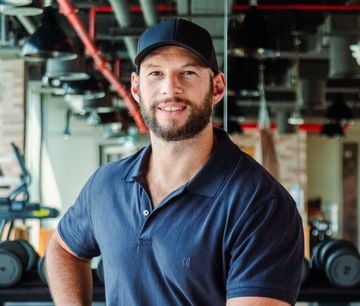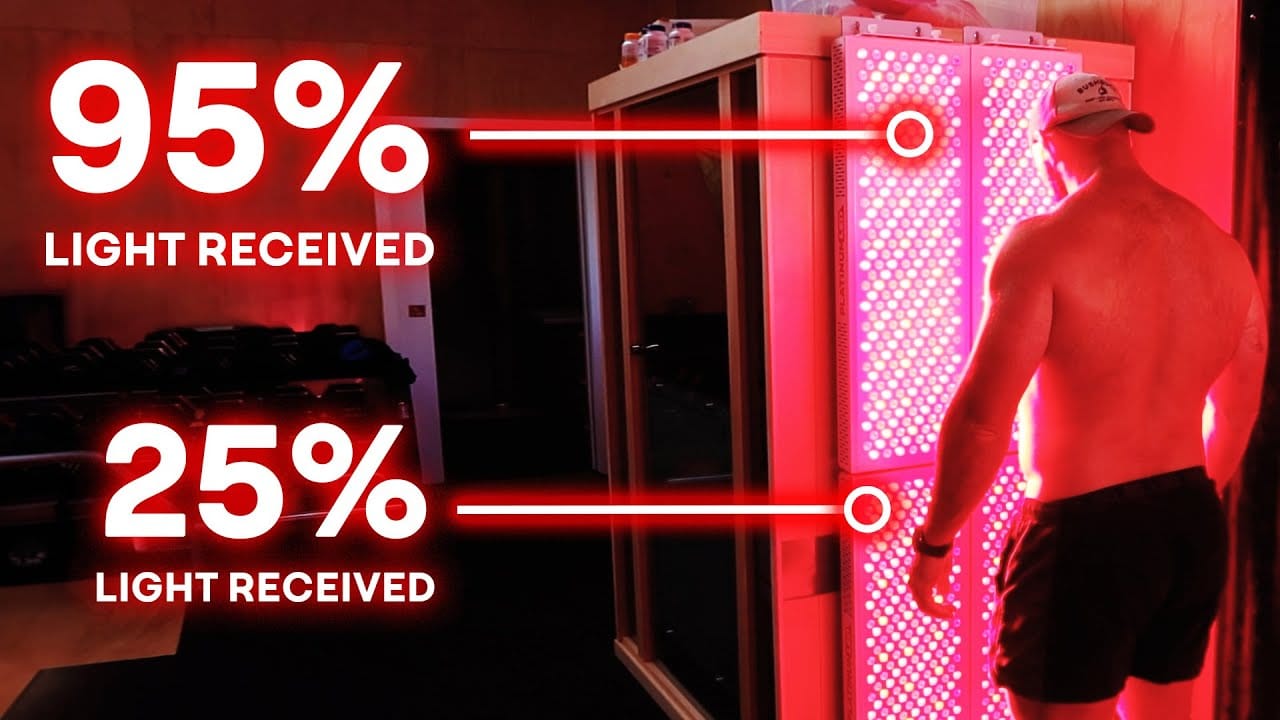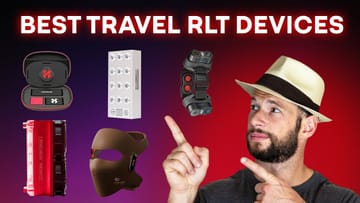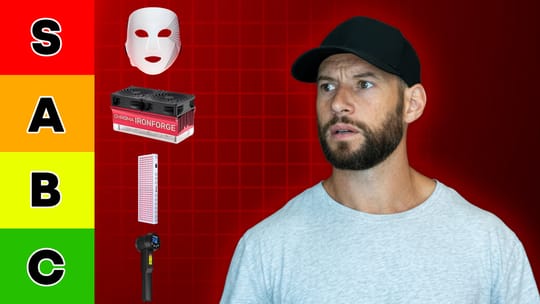What size red light therapy panel should you get? And what area does red light therapy help with? I explain both in my article below:
So, you’re shopping for a red light therapy panel and unsure what size to get. When I say “size,” I’m not talking about the number of LEDs in the panel but the actual physical dimensions—the width and height.
If you’re in this situation, this blog post is for you. Recently, I put out a video that generated some surprising results regarding red light panel sizes and coverage. It startled me, and judging by the feedback, it surprised many of you, too.
⬇️ ⬇️ Be sure to watch the first video to see the surprising results. ⬇️ ⬇️
This article follows up on that ⬆️ original video, and we’ll discuss what size red light therapy panel you need for full-body coverage.
Do Smaller Red Light Therapy Panels Cover Your Whole Body?
If you’re looking for a red light therapy panel that will give you full coverage from head to toe and shoulder to shoulder, can a standard 200-300 LED panel do the job? Many companies claim that standing 6 or 12 inches from the panel will give you total light saturation—even with smaller body panels.
These panels often come equipped with 200 to 300 LEDs, which sounds promising, but unfortunately, it probably won't give you the full coverage you’re looking for.
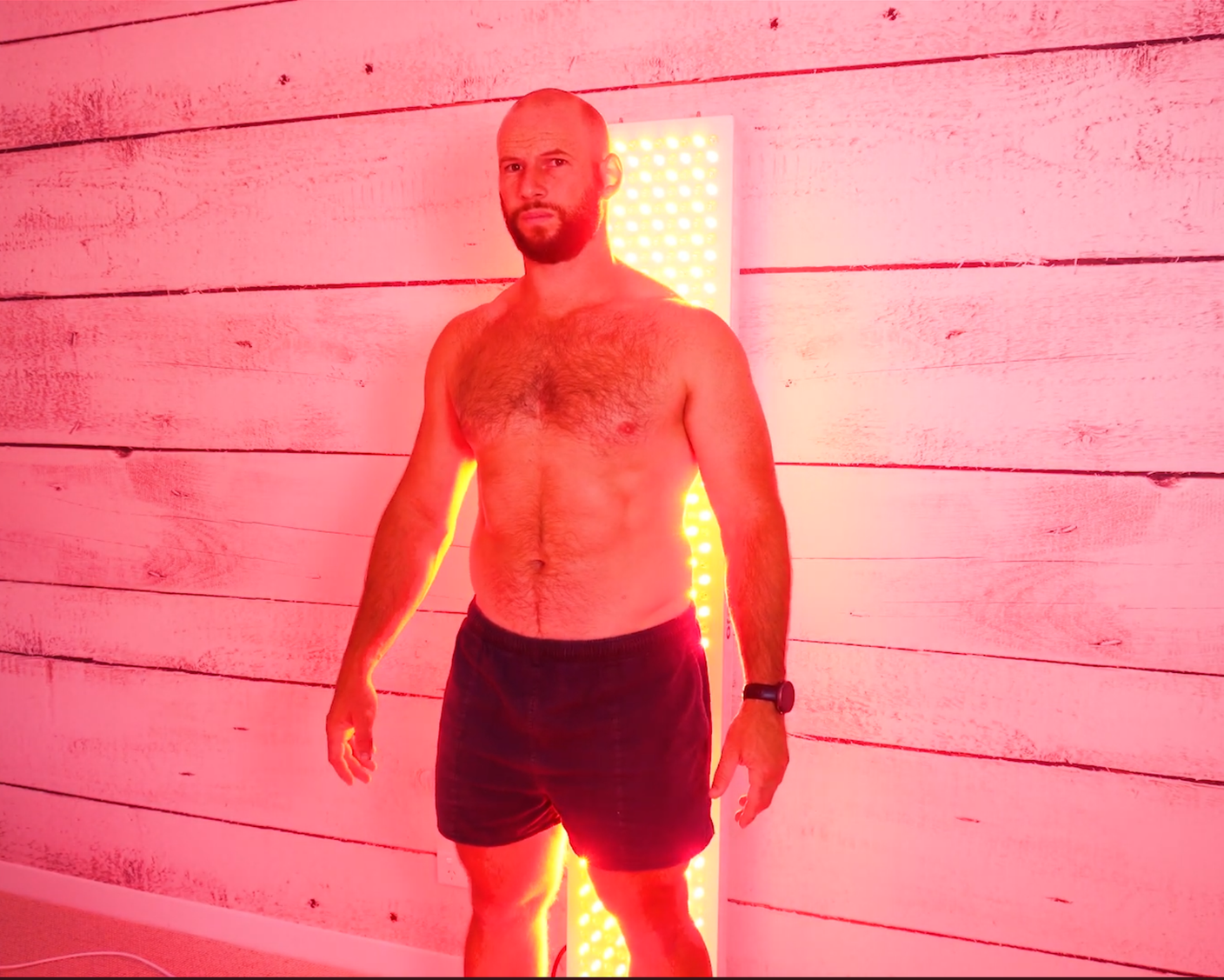
If you want full-body, high-intensity coverage, you’ll need to buy multiple body panels or invest in a large wall panel—or, even better, a red light therapy bed.
In this article, I will walk you through my setup and some findings that could change how you approach red light therapy.
My Red Light Therapy Setup:
For the past few years, I’ve used the PlatinumLED Biomax 900 quad setup, which comprises four Biomax 900 panels mounted together. At 5 foot 10 and well over 200 pounds, I always hoped this large setup would provide adequate light for my body—and today, I’m going to find out just how well it works. In addition, I’ll help you understand what to look for when choosing a panel that best suits your needs.
Testing the Biomax 900 Setup:
This setup has been my go-to for quite some time, and I love the results. To give you some context, I’m 54-55 centimeters shoulder to shoulder, and my panel setup is about the same width. However, there’s a gap in the middle between the four panels where no LEDs are present.
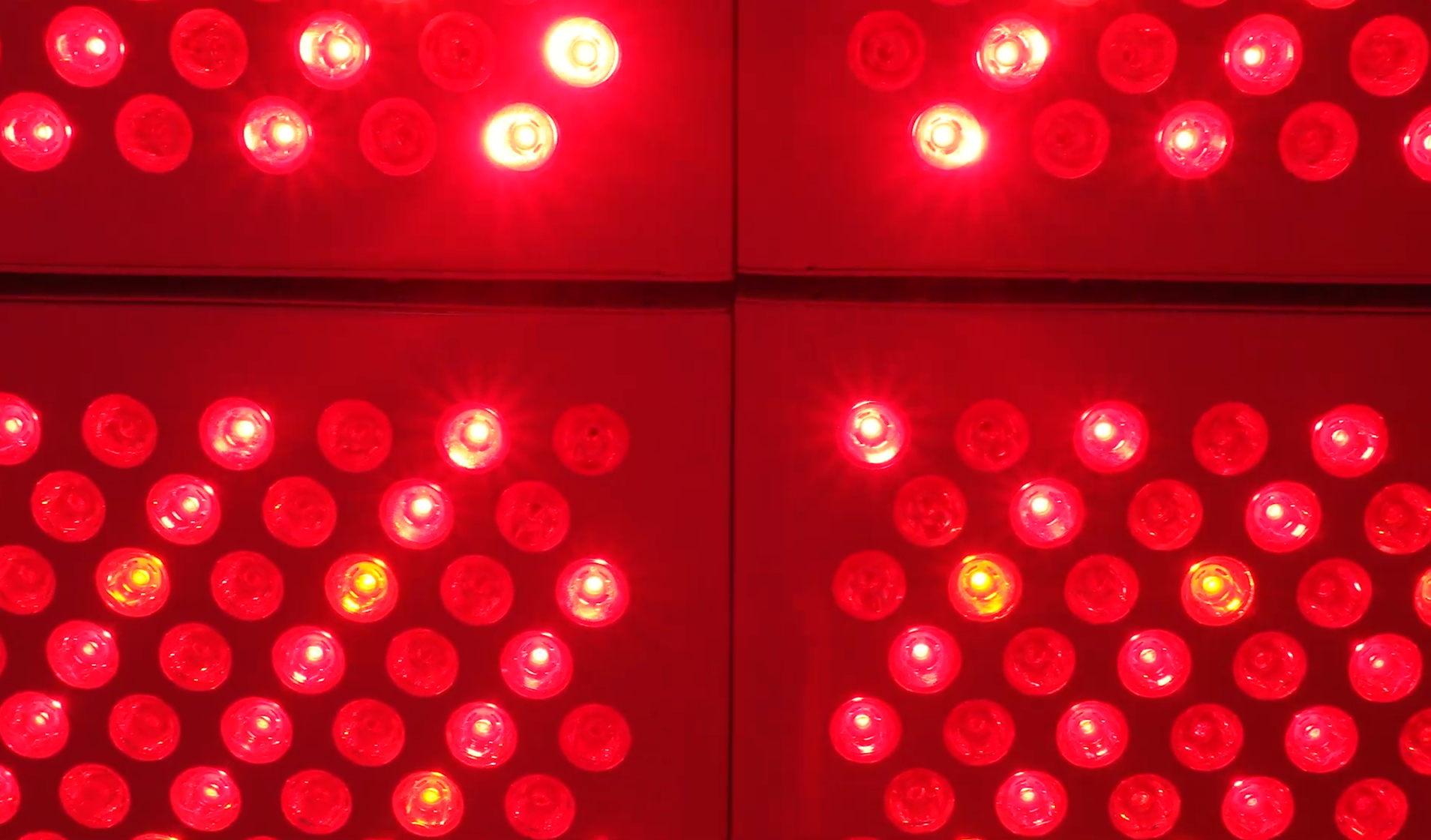
My goal today is to measure the light output at 6 inches, 12 inches, and 24 inches from the panel to see how the light spreads.
Presenting the Test Results:
To illustrate the results of our light panel test, I've set up a visual demonstration:
The Test Setup
- I've created an outline representing a person's shoulder width (let's call him Alfred).
- The outline is 55 centimeters wide, matching my own shoulder-to-shoulder measurement.
Mapping the Light Panel
- Using a red pen, I've drawn lines to show the outer edges of the LEDs on the Quad 900 panel.
- The straight lines on each side represent the panel's edges.
- In the middle, I've drawn dotted lines to indicate areas without LEDs.
Plotting Radiance Figures
I'm going to plot the radiance figures at three distances:
- 6 inches
- 12 inches
- 24 inches
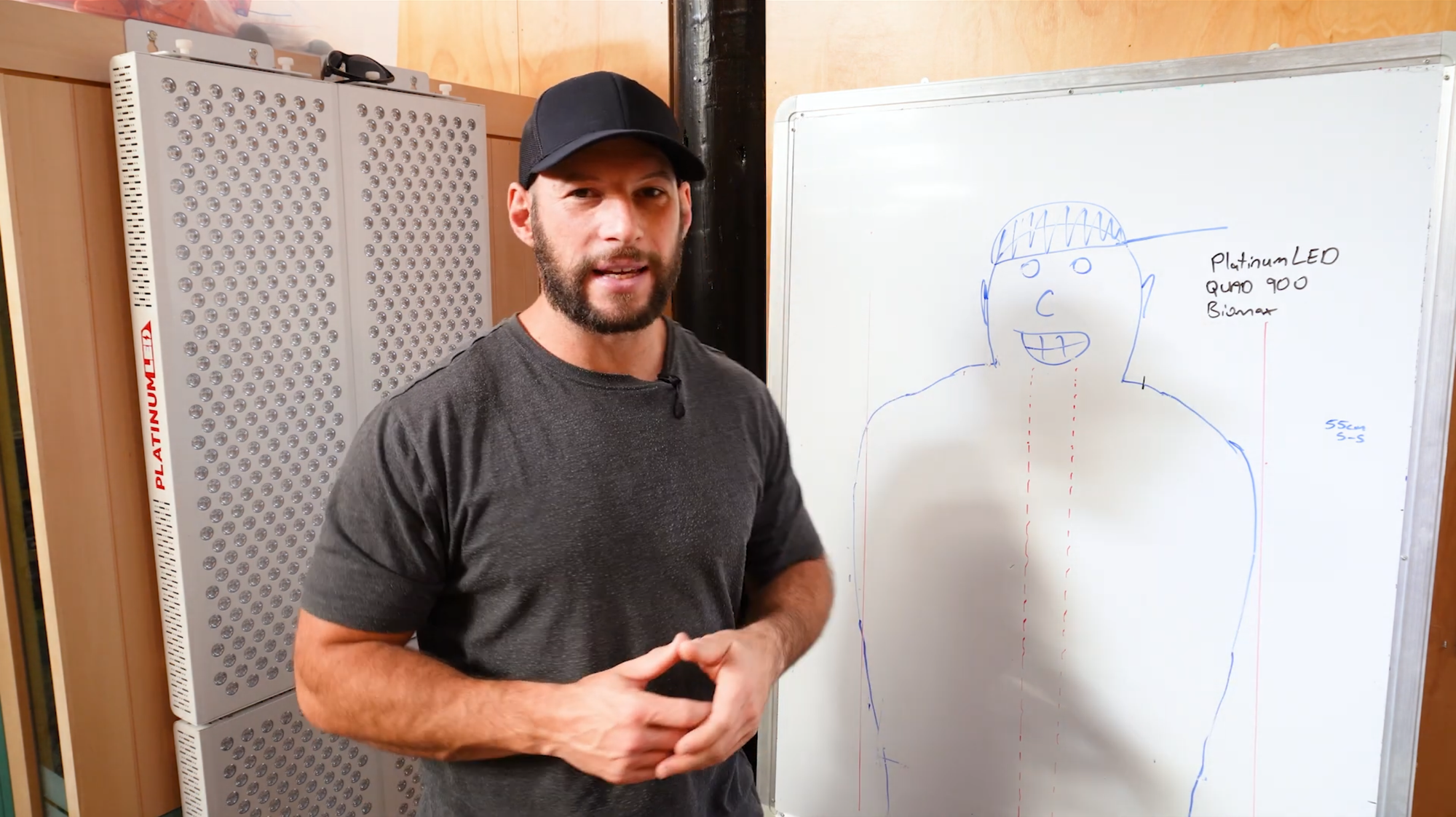
What the Numbers Reveal About Red Light Therapy Panel Performance:
When choosing a red light therapy panel, one of the most important factors is how the light spreads and how strong the irradiance (power output) is at different distances from the panel. The tests I ran on the PlatinumLED Biomax 900 quad setup revealed valuable insights.
My BioMax 900 is an older generation panel.
Testing at 6 Inches: High Power but Uneven Coverage
At 6 inches from the panel, the peak irradiance was 84 mW/cm², which is a strong power output, but the light spread wasn’t as even as I hoped. Here’s how the numbers break down:
- Peak irradiance: 84 mW/cm² right in the center of the panel.
- 80% drop-off point: The light intensity dropped to 67 mW/cm² just a few inches from the center.
- 50% drop-off point: The irradiance at 50% (half the power output of the center) was near the edge of the LED panel.
- 25% drop-off point: The irradiance at 25% was just inside the panel’s edge.
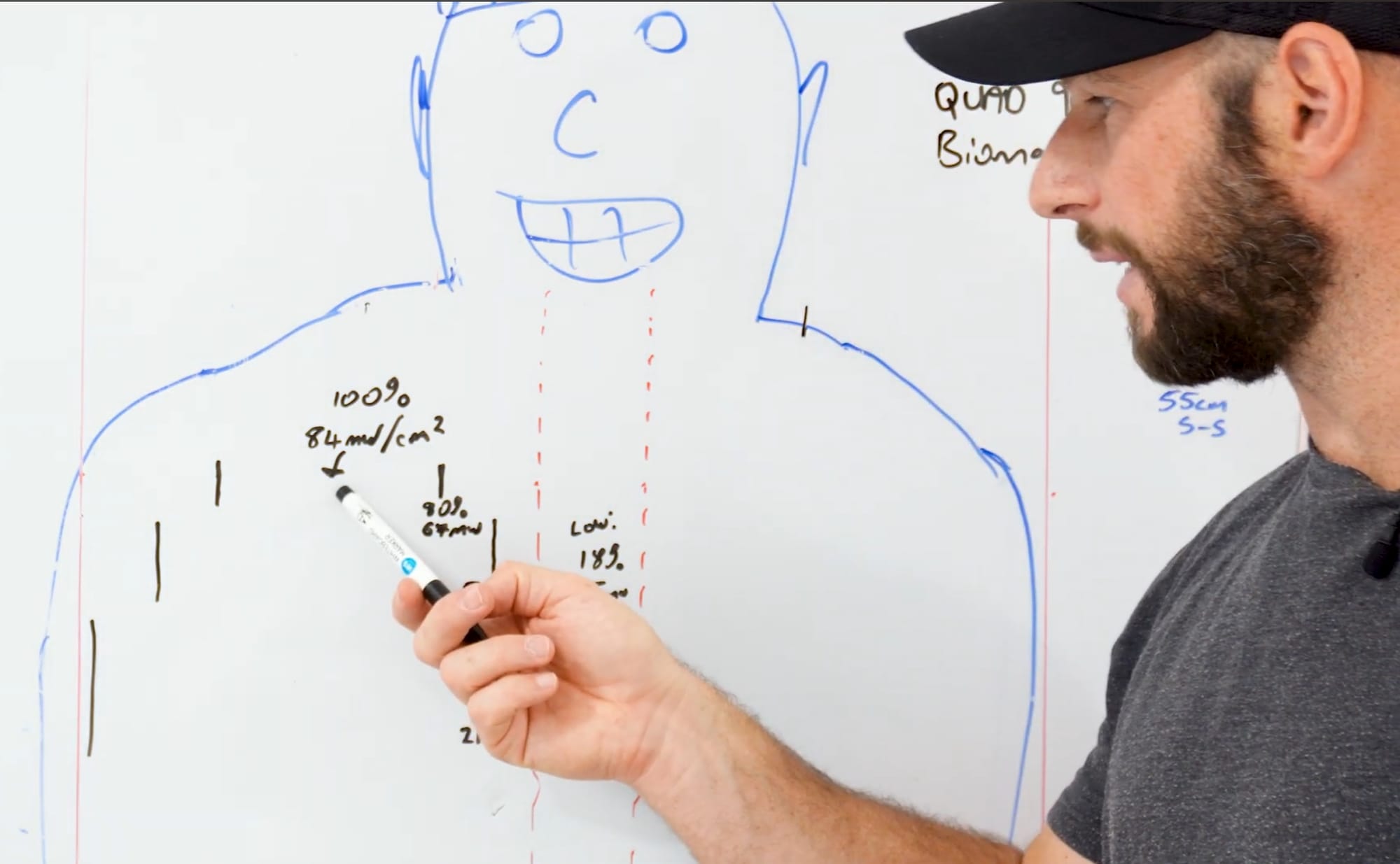
The most interesting number was the irradiance between the four panels without LEDs. The irradiance dropped to 18% of the peak, or about 15 mW/cm².
What does this mean?
If you’re standing 6 inches from the panel, you’re getting very concentrated light right in the middle of your body, particularly across the chest. But there’s a significant drop in power between the panels, meaning you’re not getting an even distribution of light across your entire body.
For instance, the irradiance in the middle of your chest might be intense, but further out towards your arms and shoulders, it’s significantly less.
Testing at 12 Inches: Improved Light Spread:
At 12 inches away, the light coverage improved dramatically. Here’s the breakdown:
- Peak irradiance: 71 mW/cm² in the center of the panel—slightly lower than at 6 inches, but still powerful.
- 80% drop-off point: The irradiance at 80% of the peak was much better spread across the face of the panel. It covered 80-90% of the LED surface, significantly improving.
- 50% drop-off point: The irradiance at 50% extended beyond the panel itself, meaning the light spread more evenly across your body.
- Lowest point (between panels): The irradiance between the panels was only 40% of the peak or 28 mW/cm². This is a significant improvement from the 18% at 6 inches.
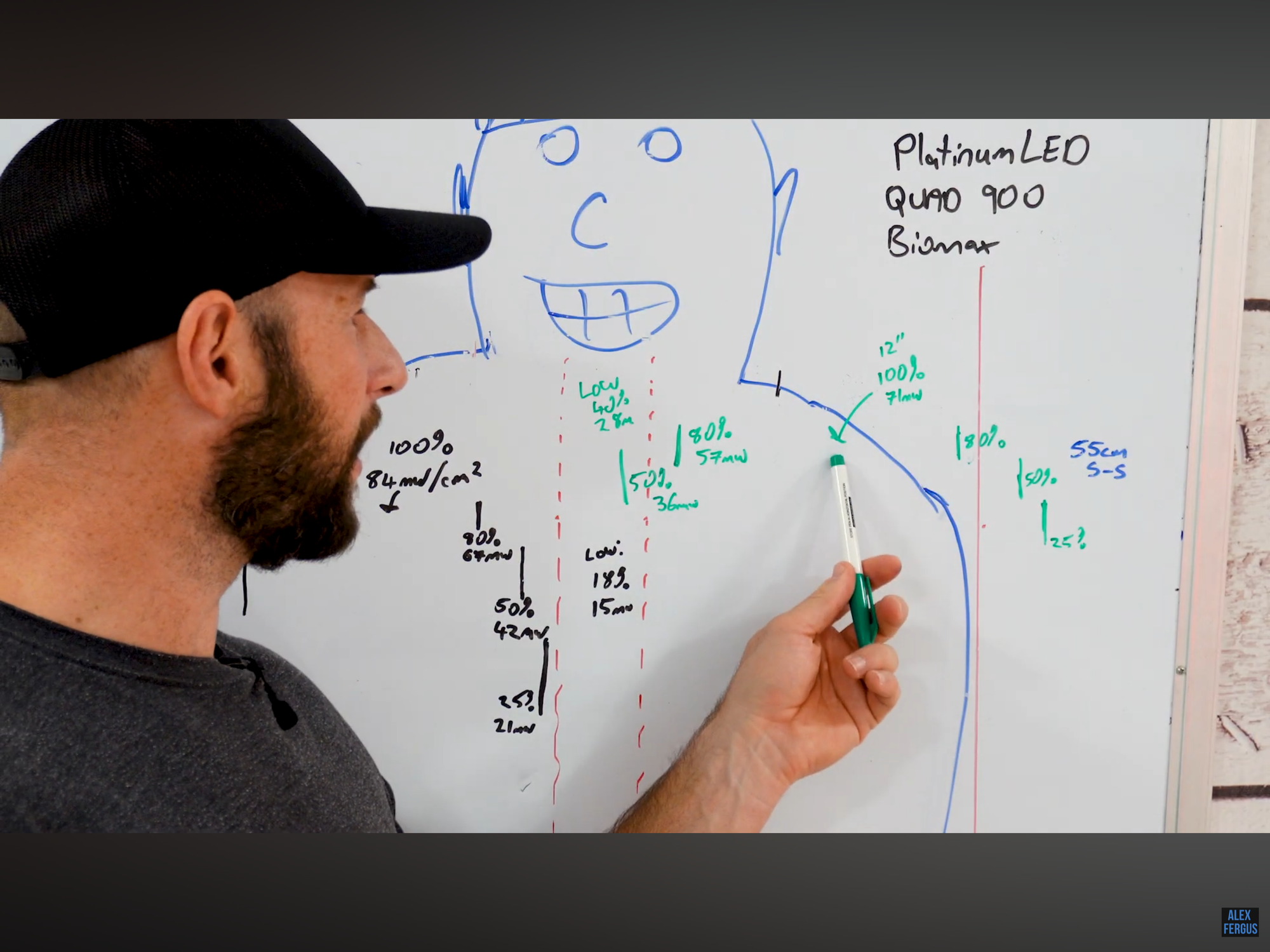
Even though the peak irradiance is lower at 12 inches than at 6 inches, the overall light coverage is far superior. The gap between the panels is less of an issue, and the light spreads evenly across your chest, shoulders, and upper body.
Key takeaway at 12 inches:
The light coverage at 12 inches is much more balanced than at 6 inches. While you’re still getting strong irradiance, the light spreads evenly across your entire body, and the gaps between the panels become less noticeable.
Testing at 24 Inches - Further Improvement in Light Spread:
The irradiance continued to drop slightly at 24 inches from the panel, but the light spread was even better. Here’s how the numbers look:
- Peak irradiance: 61 mW/cm² in the center of the panel.
- 80% drop-off point: The light spread was slightly wider than 12 inches, which is expected as you move further from the panel.
- Lowest point (in between panels): The irradiance between the panels at 24 inches was still 72% of the peak. This means the light was quite strong in the gaps between the panels, at 44 mW/cm².
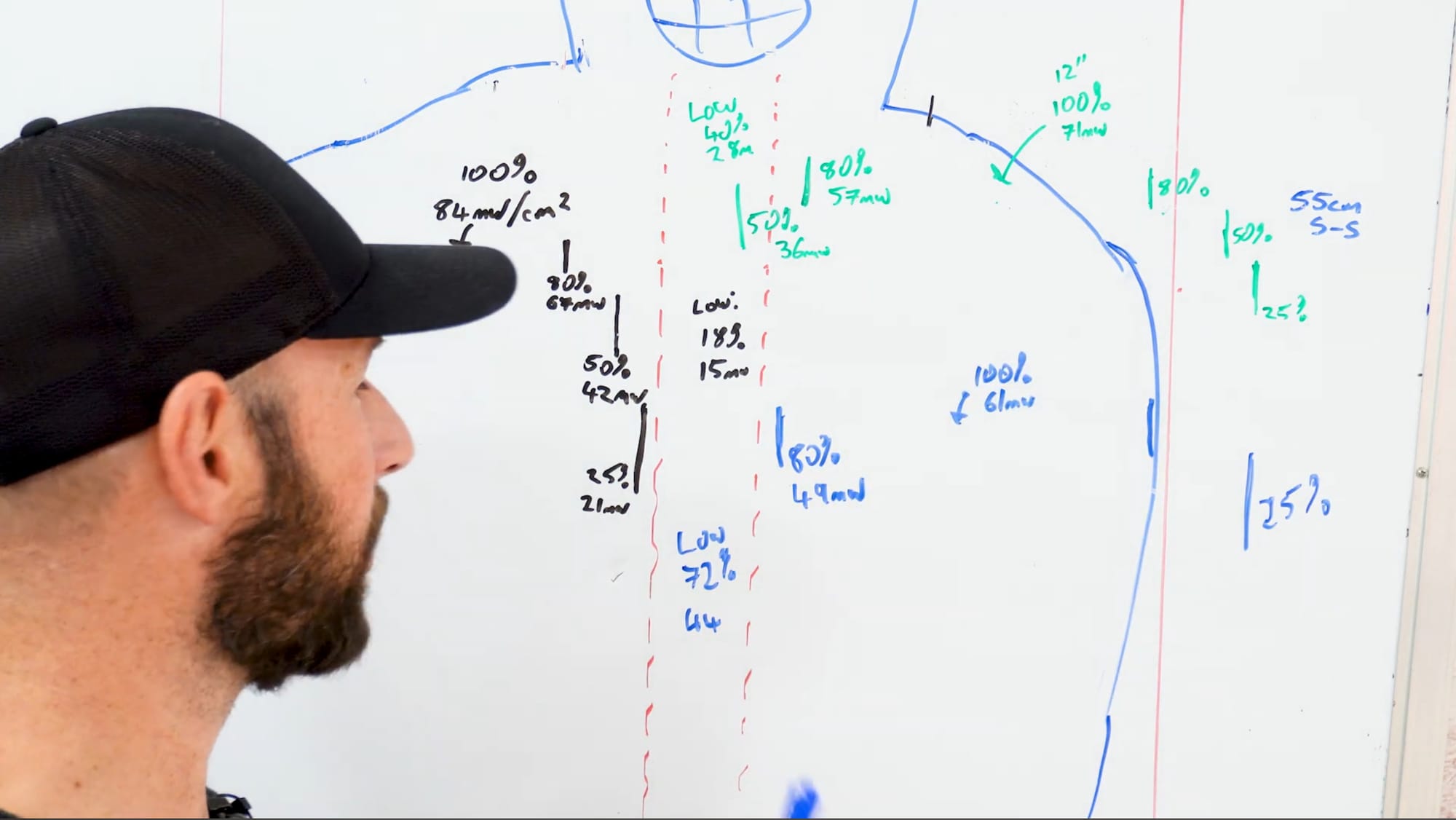
Interestingly, the lowest point in the middle of the panel (where the LEDs don’t overlap) had a relatively high irradiance—72% of the peak. This is a significant improvement over what we saw at 6 inches.
Key takeaway at 24 inches:
The overall light distribution is the most even at 24 inches. While the peak irradiance is lower than 12 inches or 6 inches, you get consistent light across your entire body, including in the gaps between the panels. Standing 24 inches from the panel provides the most balanced results if you want full-body coverage with no weak spots.
Comparing the Three Distances: What Does It All Mean?
- At 6 inches, the light is powerful but concentrated in the center. There’s a sharp drop in power between the panels, so you might not get as much light on your sides or extremities.
- At 12 inches, the light coverage improves significantly. You still get good irradiance, but the light spreads evenly across your body, reducing the weak spots between panels.
- At 24 inches, the light distribution is the most even, but the irradiance is lower. However, even at 24 inches, the power output is still strong enough to provide therapeutic benefits.
Understanding the Polka Dot Effect and Hot Spots:
One interesting observation from my previous testing with the Platinum LED Biomax 900 is the “polka dot effect” or “hot spots.” This is where you get concentrated light in certain areas (usually directly in front of the LEDs), with significant drop-offs in between. This effect is most noticeable when standing close to the panel—like at 6 inches.
However, the further away you move from the panel, the more the light blends and the polka-dot effect disappears. To avoid these hot spots and get a more consistent dose of red light therapy across your body, consider standing further back, somewhere between 12 and 24 inches.
Should You Stand Further Away From Your Red Light Panel?
Based on these results, standing further away from your red light therapy panel can improve light spread and reduce weak spots in coverage. Although 6 inches may provide more concentrated light, it won’t ensure even coverage, and you’ll miss out on benefits if certain body regions aren’t fully exposed.
If you aim for full-body treatment—shoulders, chest, neck, arms, and beyond—standing 12-24 inches away is your best bet. You’ll still get strong irradiance, but the light will spread more evenly, covering more surface area with fewer gaps.
Thoughts: Do Numbers Guide Your Decision?
Understanding the irradiance numbers and light spread at different distances can significantly affect your red light therapy results. Whether treating specific areas or seeking full-body coverage, knowing how far to stand from your panel and the size of the panel you need is essential.
As tested here, the Platinum LED Biomax 900 quad setup shows that light spread and coverage improve as you move further from the panel. While standing close provides a more intense treatment to specific areas, moving back offers more even light distribution across the entire body.
If you want the best results, consider using a more extensive panel setup like the Biomax 900 quad and position yourself at least 12-24 inches away for optimal coverage and therapeutic benefits.
Final Thoughts: Do You Need More Panels?
Now that I’ve shown you these results, I’m curious—does this change what you were considering buying? Will you need more panels, or are you reconsidering what size panel to get?
Remember, even smaller panels offer systemic benefits, so if you’re on a budget, don’t worry! With a smaller panel, you can still gain significant health improvements from red light therapy, even if it doesn’t completely cover your entire body.
Full-body coverage is vital for those looking for maximum benefits, and standing further back from the panel ensures you’re getting a nice, even spread of therapeutic light.
Here's my breakdown of the best red light therapy wall panels.
I test 17 panels in this comparison series.
Here's my latest video on full-body red light therapy panels - whereby you can buy just one panel and get full-body coverage:
Make sure to watch these two videos - even though they're long - before making a decision! Nevertheless, the answer to question of my article about "what area does red light therapy help with" is answered by the biggest red light therapy treatment area you can afford!
Items mentioned in this Article:
- For a PlatinumLED BioMax panel - you get the discount code after clicking the link
Consider These YouTube Videos As Well:
🔴 PlatinumLED Biomax Vs Block Blue Light Mega: BIG Battle
🔴 Mito Red MitoPRO Mega X Review: Decent Option BUT...
🔴 Block Blue Light Elite XL: Consider THIS Before You Buy!
🔴 Rojo Refine 3600 Review: The PERFECT Panel, Or Not!?
🔴 Rouge Ultimate G3 Review: BIGGEST Panel I've Tested!
Found This Interesting? Look At These Articles:
🔴 Red Light Therapy For Eye Health: The Very Impressive Science
🔴 Red Light Therapy Wavelengths Benefits: The Ultimate Guide
🔴 Is Red Light Therapy Science-Based? An Introduction
🔴 The Remarkable Role Of Light Therapy In Periodontal Care
🔴 Red Light Therapy For Neuropathy: The Promising Science
Alex Fergus wrote this blog post. Alex is an ISSN Sports Nutrition Specialist, Fitness Professional, and certified Superhuman Coach who continues to expand his knowledge base and help people worldwide with their health and wellness. Alex is recognized as the National Record Holder in Powerlifting and Indoor Rowing and has earned the title of the Australian National Natural Bodybuilding Champion. Having worked as a health coach and personal trainer for over a decade, Alex now researches all things health and wellness and shares his findings on this blog.
